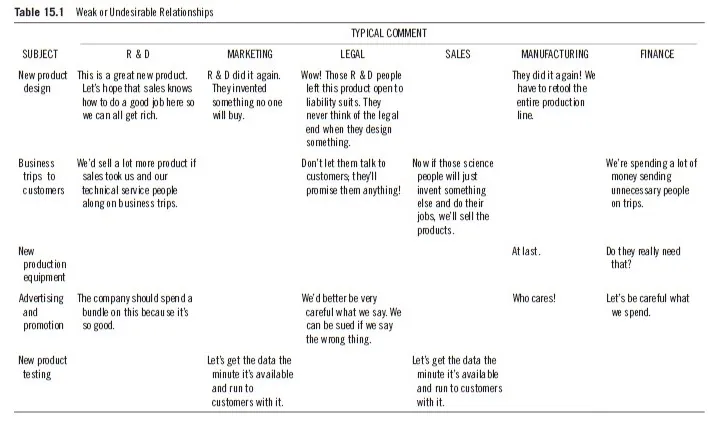At times, company business and technical functions seem to occupy two different worlds. a corporation that needs technical functions cannot maximize its profits when these two areas are up to now apart and don’t work together effectively. How can they be doing good jobs for the company if they’re out of sync? Business and technical functions are not different planets operating where they choose within the corporate orbit. they need to be kept in alignment.
The two areas might not be at odds; they simply might not understand each other. How then does one get them to figure together more effectively?
The first step is to possess them understand one another, but this is easier said than done. the method is comparable to convincing people to see other views in an endeavor to achieve understanding, if not agreement.
It is satisfying and rewarding to find out to cater to people.
Similarly, understanding and cooperating with another function in a company results in appreciation, then possibly agreement, and ultimately a symbiotic relationship which will cause maximizing profits.
Effective communication plays a serious role in aiding understanding of various company functions and enhancing their ability to figure together.
In some companies, technical and business functions “get along well,” often in small companies where people see one another daily. In larger companies, maintaining relationships through education and well-planned, constructive meetings of the assorted disciplines ensures that this mutual affection and appreciation continues. Proper interdepartmental relationships is established and maintained when all parties have some understanding of every other. Table 15.1 illustrates weak and/or undesirable relationships (little understanding)

among typical company areas. Each area exhibits a special view because it focuses inward and fails to determine the necessity for interaction. You are invited to imagine what comments on the a part of your company operations would fit into the empty areas of the table. you’ll devise a similar chart or copy this one. you will find that various departments or divisions of your company have very interesting opinions, and you can use such information to work out how you may create better agreement which will cause better workflow, more and better products, and more profits.
Table 15.2 portrays good working relationships among company areas. it’d be great if your relationships were kind of like those shown within the table. Try the exercise above with Table 15.2. If your company relationships lie somewhere between the extremes of Tables 15.1 and 15.2 and lean toward the latter, your divisions probably get along well.
The example below depicts what can happen when coordination between departments appears good on the surface but is unsatisfactory.
The incident really happened and such problems still occur during this and other industries with other products. The industry involved within the incident manufactured rubber stoppers of the categories used to seal vials of flu vaccine. Doctors withdraw vaccines from such vials for injection into patients. The rubber stoppers are very carefully designed in order that little or no material utilized in their manufacture will extract into the injectable solution and cause harm to patients.
A customer of the rubber stopper maker, a serious pharmaceutical manufacturer, was curious about a brand new stopper formula in development.
The salesman who serviced the company paid frequent visits to the research department to work out what innovations he could want his customer. A stopper manufacturer makes money by selling plenty of product. A typical stopper may cost about five cents to manufacture. If a corporation sells them for nine cents each, the profit on a monthly order from one customer for five million stoppers is handsome and that we can assume the corporate has other customers.
The research and development department developed a replacement stopper formula that exhibited the specified chemical properties. The research people visited the pilot plant to acquire stoppers made of the new formulation. The pilot plant sorted out the imperfect stoppers and produced a box of some hundred good looking stoppers, without mentioning that for each good stopper produced, nine imperfect ones had to be thrown out! This represents a 90% reject level, or discarding 900 of every 1000 stoppers produced. Producing stoppers at a value of 5 cents each is nice, assuming no rejects. Producing just one good stopper of each ten escalates the assembly cost to fifty cents per stopper. This information had not yet been conveyed from the pilot plant to the research department. the salesperson visited the pilot plant, saw the nice stoppers, and delivered 100 samples to his customer.
The customer liked the stoppers and after accelerated testing of the samples, placed a awfully task.
Now, take an in depth take a look at the case. the salesperson had an order for 10 million stoppers he thought cost five cents each and sold for nine cents. In reality, he was selling for nine cents new stoppers that cost fifty cents to create. the salesperson had to admit to the customer that he acted prematurely which the formulation wasn’t yet ready to sell. The customer had almost founded a production schedule for sealing one in every of its products in vials using this new stopper. Had that occurred, it’d have cost the customer tens of thousands of dollars to retool its equipment and therefore the stopper manufacturer would have been expected to soak up some or all of that cost because it promised to deliver the new product.

This is a real example of an issue arising from a scarcity of communication.
Be careful to forestall the transmittal of piecemeal or incorrect information from one department to a different before all the fine points are puzzled out. Have effective communications among the various departments if you would like to create and sell your product or service efficiently. it’s easy for a salesman to speak a few product; it is not really easy to deliver what he promised, as promised, and on time. When communications about costs, availability, and production issues flow well interdepartmentally, a product or service is provided at a convenience to the customer and a profit to you.
The reverse situation also can occur. Perhaps a product is prepared to travel to the market and company management is timid about introducing it until it’s tested endlessly. an honest case in point concerns a harness maker in 1900 who wanted to form the best harness available. He isolated himself in his workshop for 3 years to develop the harness; his wife even delivered his meals to his workshop. He had made several high quality harnesses but continued to strive for perfection. When he emerged from his workshop after three years, he was surprised at the sight he beheld. People now not rode horses! The contraption now called a car was used for transport and other people not needed harnesses. This continues to happen today. Management may have a decent product, but if it delays getting its product to the market promptly, a competitor whose product is also inferior may capture the market share.
These two examples clearly show that timeliness could be a key factor along with the correct dissemination of data within an organization.
Relationships among departments and areas tend to be close when a company starts up, but may diminish as an organization grows. Remember the example of a mobile utilized in Chapter 1—displacement of 1 segment forced the whole mobile to shift to regain equilibrium. An unexpected shift causes an excellent disruption, but a planned shift should be effectively accommodated by all divisions or departments.
The best thanks to avoid any problems is to consistently demand accurate and effective communication among divisions. More are said about communication within the next chapter. For now, confine mind that communications among the assorted functions facilitate introduction of products to the market and modifications of existing products.
Effective interdepartmental communications ultimately result in the generation of profits for the corporate.


